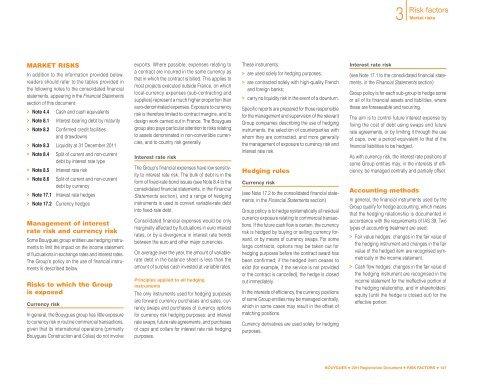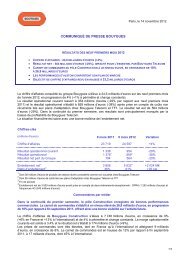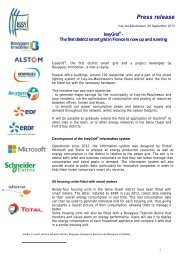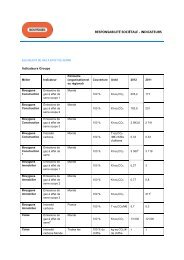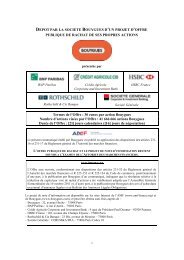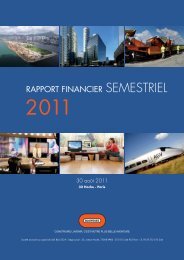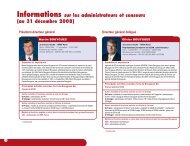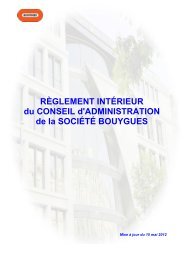Registration Document BOUYGUES
Registration Document BOUYGUES
Registration Document BOUYGUES
Create successful ePaper yourself
Turn your PDF publications into a flip-book with our unique Google optimized e-Paper software.
3 Market<br />
Risk factors<br />
risks<br />
MARKET RISKS<br />
In addition to the information provided below,<br />
readers should refer to the tables provided in<br />
the following notes to the consolidated financial<br />
statements, appearing in the Financial Statements<br />
section of this document:<br />
> Note 4.4 Cash and cash equivalents<br />
> Note 8.1 Interest-bearing debt by maturity<br />
> Note 8.2 Confirmed credit facilities<br />
and drawdowns<br />
> Note 8.3 Liquidity at 31 December 2011<br />
> Note 8.4 Split of current and non-current<br />
debt by interest rate type<br />
> Note 8.5 Interest rate risk<br />
> Note 8.6 Split of current and non-current<br />
debt by currency<br />
> Note 17.1 Interest rate hedges<br />
> Note 17.2 Currency hedges<br />
Management of interest<br />
rate risk and currency risk<br />
Some Bouygues group entities use hedging instruments<br />
to limit the impact on the income statement<br />
of fluctuations in exchange rates and interest rates.<br />
The Group's policy on the use of financial instruments<br />
is described below.<br />
Risks to which the Group<br />
is exposed<br />
Currency risk<br />
In general, the Bouygues group has little exposure<br />
to currency risk in routine commercial transactions,<br />
given that its international operations (primarily<br />
Bouygues Construction and Colas) do not involve<br />
exports. Where possible, expenses relating to<br />
a contract are incurred in the same currency as<br />
that in which the contract is billed. This applies to<br />
most projects executed outside France, on which<br />
local-currency expenses (sub-contracting and<br />
supplies) represent a much higher proportion than<br />
euro-denominated expenses. Exposure to currency<br />
risk is therefore limited to contract margins, and to<br />
design work carried out in France. The Bouygues<br />
group also pays particular attention to risks relating<br />
to assets denominated in non-convertible currencies,<br />
and to country risk generally.<br />
Interest rate risk<br />
The Group's financial expenses have low sensitivity<br />
to interest rate risk. The bulk of debt is in the<br />
form of fixed-rate bond issues (see Note 8.4 to the<br />
consolidated financial statements, in the Financial<br />
Statements section), and a range of hedging<br />
instruments is used to convert variable-rate debt<br />
into fixed-rate debt.<br />
Consolidated financial expenses would be only<br />
marginally affected by fluctuations in euro interest<br />
rates, or by a divergence in interest rate trends<br />
between the euro and other major currencies.<br />
On average over the year, the amount of variablerate<br />
debt in the balance sheet is less than the<br />
amount of surplus cash invested at variable rates.<br />
Principles applied to all hedging<br />
instruments<br />
The only instruments used for hedging purposes<br />
are forward currency purchases and sales, currency<br />
swaps and purchases of currency options<br />
for currency risk hedging purposes; and interest<br />
rate swaps, future rate agreements, and purchases<br />
of caps and collars for interest rate risk hedging<br />
purposes.<br />
These instruments:<br />
> are used solely for hedging purposes;<br />
> are contracted solely with high-quality French<br />
and foreign banks;<br />
> carry no liquidity risk in the event of a downturn.<br />
Specific reports are prepared for those responsible<br />
for the management and supervision of the relevant<br />
Group companies describing the use of hedging<br />
instruments, the selection of counterparties with<br />
whom they are contracted, and more generally<br />
the management of exposure to currency risk and<br />
interest rate risk.<br />
Hedging rules<br />
Currency risk<br />
(see Note 17.2 to the consolidated financial statements,<br />
in the Financial Statements section)<br />
Group policy is to hedge systematically all residual<br />
currency exposure relating to commercial transactions.<br />
If the future cash flow is certain, the currency<br />
risk is hedged by buying or selling currency forward,<br />
or by means of currency swaps. For some<br />
large contracts, options may be taken out for<br />
hedging purposes before the contract award has<br />
been confirmed; if the hedged item ceases to<br />
exist (for example, if the service is not provided<br />
or the contract is cancelled), the hedge is closed<br />
out immediately.<br />
In the interests of efficiency, the currency positions<br />
of some Group entities may be managed centrally,<br />
which in some cases may result in the offset of<br />
matching positions.<br />
Currency derivatives are used solely for hedging<br />
purposes.<br />
Interest rate risk<br />
(see Note 17.1 to the consolidated financial statements,<br />
in the Financial Statements section)<br />
Group policy is for each sub-group to hedge some<br />
or all of its financial assets and liabilities, where<br />
these are foreseeable and recurring.<br />
The aim is to control future interest expense by<br />
fixing the cost of debt using swaps and future<br />
rate agreements, or by limiting it through the use<br />
of caps, over a period equivalent to that of the<br />
financial liabilities to be hedged.<br />
As with currency risk, the interest rate positions of<br />
some Group entities may, in the interests of efficiency,<br />
be managed centrally and partially offset.<br />
Accounting methods<br />
In general, the financial instruments used by the<br />
Group qualify for hedge accounting, which means<br />
that the hedging relationship is documented in<br />
accordance with the requirements of IAS 39. Two<br />
types of accounting treatment are used:<br />
> Fair value hedges: changes in the fair value of<br />
the hedging instrument and changes in the fair<br />
value of the hedged item are recognised symmetrically<br />
in the income statement.<br />
> Cash flow hedges: changes in the fair value of<br />
the hedging instrument are recognised in the<br />
income statement for the ineffective portion of<br />
the hedging relationship, and in shareholders'<br />
equity (until the hedge is closed out) for the<br />
effective portion.<br />
<strong>BOUYGUES</strong> • 2011 <strong>Registration</strong> <strong>Document</strong> • RISK FACTORS • 147


